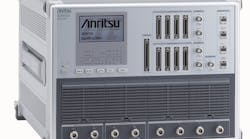LTE-Advanced Carrier-Aggregation Card Blazes At 150 Mb/s
Aggregation of two 2x2 multiple-input, multiple-output (MIMO) carriers into one “pipe” brings 150-Mb/s speed to a new LTE-Advanced carrier-aggregation (CA) device. Demonstrated at CTIA2013, the NETGEAR AirCard 780S Mobile Hotspot used Anritsu’s MD8430A LTE network simulator with Rapid Test Designer (RTD) test sequences to reach that throughput level. LTE-Advanced CA allows wireless service providers to harness fragmented spectrum resources to boost speed and coverage to LTE subscribers.
The MD8430A can simulate as many as two active and four interfering LTE basestations on as many as four RF channels (see figure). It’s possible to simulate a mix of frequency-division-duplex (FDD) and time-division-duplex (TDD) base stations using multiple MIMO configurations for each base station [e.g., single input, single output (SISO), 2x2 MIMO, or 4x2 MIMO). Among the advanced Release 8, 9, and 10 features available are carrier aggregation, dual-layer beamforming, Enhanced Multimedia Broadcast Multicast Service (eMBMS), and semi-persistent scheduling (SPS).
With MX786201A RTD scripting software, users are able to create tests that can’t be performed with traditional language-based tools. RTD supports testing at multiple layers in the device stack. Low-Level Procedure Libraries handle the early stages of device development, while auto-configuring Layer 3 Procedure Libraries tackle the later stages. Reference Test Cases and Integration Libraries facilitate the building of customized test cases and libraries.
